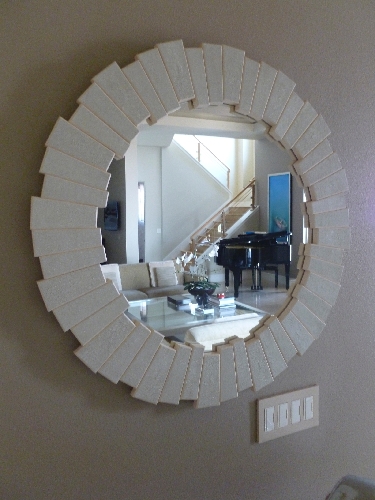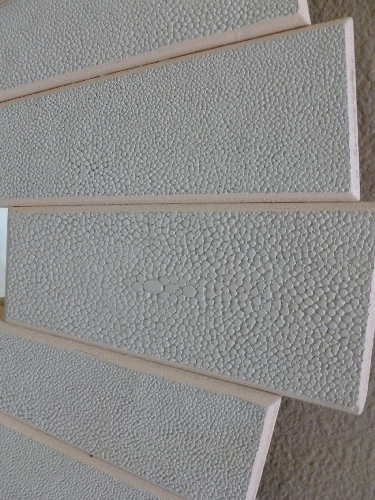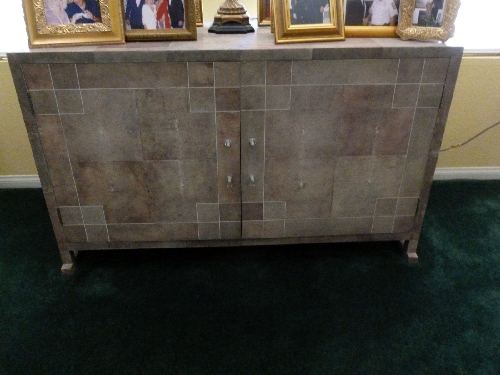Faux shagreen outshines, outperforms real material
When the oversized package finally arrived, its size wasn't the only surprise. No, its contents, a custom mirror shipped from the other side of the world, proved to be not only a revelation for its craftsmanship, but for a faux finish I wasn't entirely sure would meet my expectations - even though the original sample had looked really good. All the while it was in production, I kept wondering and hoping that the finish would measure up to the time-honored and highly revered original shagreen that it was meant to simulate.
If you're not yet familiar with shagreen, an incredible surface, you soon will be because it's taking the design world by storm, and in a new and environmentally friendly form - faux shagreen. It seems to be everywhere these days, with its popularity steadily growing with each new table, lamp or box that appears in the marketplace. It may be the total finish on a piece or just a trim or accent - but it's there!
Genuine shagreen, which is still used in high-end applications and is probably most closely associated with the art deco era (when designers like Clement Rousseau and Jean-Michael Frank used shagreen to create their most sumptuous furniture), has remained a prized and luxurious decorative material for many centuries and has always been synonymous with luxury and the exotic. These skins, with their smoothly pebbled texture, have, in fact, been cherished since the ancient pharaohs in Egypt and then later by Japanese samurai in the Middle Ages for use on their sword hilts and armor. So, it's got quite a history.
But, today the real article seems to be taking a backseat in the design world, which is presently so cognizant and in step with the green movement and sustainability. Real shagreen has actually become quite controversial since the use of skins from stingrays or sharks is now frowned upon by so many of us concerned about the environment.
For example, a while back, I wrote a column on real shagreen (which I've loved for a long time) and received the following "fan letter" from a reader:
"I read your article on 'shagreen.' I found it rather disgusting. I would think as a society, there would be progress in design - not regression to barbarism. Skinning animals to wrap their skin around a piece of 'furniture' really has no appeal to me and for those who do find it so 'magnificent' ought to get back into nature and enjoy the harmony therein - which cannot be 'bought' no matter how wealthy one is. I would rather have a chair made of fabric - a table made of recycled wood than look at a dead animal (skin) that was sacrificed to further pump someone's already overblown ego, and become part of their 'collection' of death. Just my thoughts."
Understandably some have very strong feelings on this subject and believe that the use of the real shagreen may actually threaten the species. On the other hand, designers who use the material insist that their practice only uses sustainably sourced remnants from the fishing industry. I suppose the truth lies somewhere in between these two positions. While all sorts of objects in both real and faux shagreen, such as tables, decorative boxes and picture frames, proliferate, faux shagreen grows stronger by the day - and I can see why.
Faux shagreen (if you haven't already guessed) is a vinyl material , though it's also available in leather. It has a repeating pattern that renders it far less costly than the real deal, which remains so expensive because of the small area of fish skin that can actually be used (normally only a rectangle in the center) coupled by the work and skill necessary to prepare and ultimately inlay them. Can you imagine the labor and time it must take to prepare and cure the shagreen? Hence, the great cost factor for this material.
But, in fairness, it needs to be pointed out that designers have always loved real shagreen because every skin has a subtly different tone in the raw process while vinyl is vinyl. Even tanned skins (leather) have a very consistent tone given the chromium treatment that prepares them. Anyone who has seen or touched traditionally made shagreen items will see why it has been cherished in Japan and by the great deco masters and why it's used today throughout Asia and in so many luxury brand accessories.
Still, in my experience, the faux version is considerably more durable than actual shagreen, which can dry out over time and easily break off leaving a deep crevice difficult, if not impossible, to repair. It is very sad when that happens to something so costly and difficult to replace.
With these facts in mind, it's easy to understand why faux shagreen has become popular now that the real skins can be so flawlessly imitated and made in any color or pattern. One manufacturer has even referred to it as "couture shagreen." It's a modern and handsome material based on a long-sought-after finish, that adds just the right amount of warmth and texture to anything from nesting tables to desk accessories, lamps, trays and clocks. It's even widely available as wallpaper - imagine that!
Plan to add a piece or two of shagreen to your home décor now that faux shagreen has reached such brilliant heights. You can recreate the exotic look of this incredible material for a fraction of the cost.
Stephen Leon is a licensed interior designer and president of Soleil Design; he has been designing and manufacturing custom furniture and cabinetry for more than 25 years. He has served on the board of directors of the Central California/Nevada Chapter of the American Society of Interior Designers and is a certified professional in green residential design. Questions can be sent to soleildesign@cox.net.






























